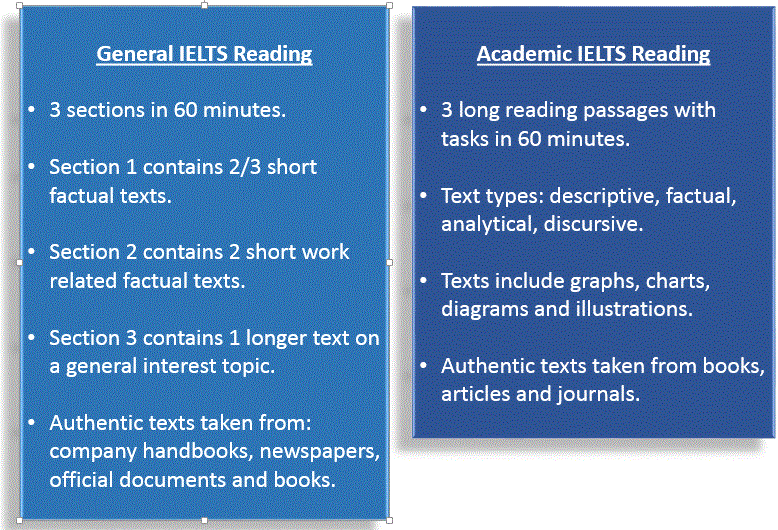IELTS Reading Strategies for Score Boosting
IELTS Reading Strategies for Score Boosting
Academic and If you are taking IELTS to study abroad then you will take the Academic IELTS Reading Module.
If you are taking IELTS for other purposes such as working abroad, then you will take the General Training Reading Module. Either way, improving your reading for IELTS is important as you will face some complex reading and difficult vocabulary.
The aim of these pages is to give you the skills and practice to tackle the reading module.
Either way, improving your reading for IELTS is important as you will face some complex reading and difficult vocabulary.
The aim of these pages is to give you the skills and practice to tackle the reading module.
 Both IELTS Reading Tests, Academic and General Training, aim to assess the following skills:
Both IELTS Reading Tests, Academic and General Training, aim to assess the following skills:
- Reading for gist
- Reading for main ideas
- Reading for detail
- Understanding inferences and implied meaning
- Recognising a writers opinions
- Attitudes and purpose
- Following the development of an argument
The Academic IELTS Reading Module
IELTS Reading Strategies for Score Boosting
 The Academic IELTS Reading Module takes 60 minutes and there are 40 questions to answer. Each question is worth 1 mark.
The Reading Passages
There are three reading passages with a total of 2,150-2,750 words. Texts are taken from journals, magazines, books, and newspapers.
All the topics are of general interest and the texts have been written for a non-specialist audience. The readings are intended to be about issues that are appropriate to candidates who will enter postgraduate or undergraduate courses.
The Academic IELTS Reading Module takes 60 minutes and there are 40 questions to answer. Each question is worth 1 mark.
The Reading Passages
There are three reading passages with a total of 2,150-2,750 words. Texts are taken from journals, magazines, books, and newspapers.
All the topics are of general interest and the texts have been written for a non-specialist audience. The readings are intended to be about issues that are appropriate to candidates who will enter postgraduate or undergraduate courses.
 At least one text will contain detailed logical argument. One of the texts may contain non-verbal materials such as graphs, illustrations or diagrams.
If there are technical terms which you may not know in the text then a glossary is provided. The texts and questions become more difficult through the paper.
The Questions
Instructions are clear and easy to follow and you will be provided with examples of any unfamiliar question types. Texts and questions appear on a Question Paper which you can write on but not take away from the test room.
You must answers all questions on an Answer Sheet during the 60 minutes – there is not extra time at the end to transfer your answers to an answer sheet.
The position of the questions varies – some of the questions may come before a passage, some may come after, depending on the question type.
These are the types of question you can expect to see in the test:
At least one text will contain detailed logical argument. One of the texts may contain non-verbal materials such as graphs, illustrations or diagrams.
If there are technical terms which you may not know in the text then a glossary is provided. The texts and questions become more difficult through the paper.
The Questions
Instructions are clear and easy to follow and you will be provided with examples of any unfamiliar question types. Texts and questions appear on a Question Paper which you can write on but not take away from the test room.
You must answers all questions on an Answer Sheet during the 60 minutes – there is not extra time at the end to transfer your answers to an answer sheet.
The position of the questions varies – some of the questions may come before a passage, some may come after, depending on the question type.
These are the types of question you can expect to see in the test:
- short-answer questions
- multiple choice
- sentence completion
- notes/summary/diagram/flow chart/table completion
- choosing a heading for a paragraph
- identification of writer’s views/claims – yes, no or not given
- identification of information – true, false or not given
- classification
- matching lists/phrases.
The General Training Module
As with the Academic IELTS reading, the General Training reading module takes 60 minutes, there are 40 questions, and each one is worth 1 mark. The Reading Passages The readings are 2,150-2,750 words, each text being harder than the one before. In contrast to the Academic Reading, texts are taken from advertisements, notices, booklets, official documents, leaflets, newspapers, timetables, instruction manuals, books and magazines. They are all authentic. These are texts that you are likely to have to deal with daily in an English speaking country. Section one: This section contains 2-3 short factual texts with topics that will be relevant to your everyday life when you live abroad in an English environment. For example, a text may consist of a number of advertisements. Section two: There are 2 factual texts and they focus on issues related to work such as applying for a job, pay and conditions, staff training and development and company policies. Section three: The text in this section is longer and more difficult. It is a text on a topic of general interest. The Questions As with the Academic IELTS reading, these are the questions you can expect to see on the test:- short-answer questions
- multiple choice
- sentence completion
- notes/summary/diagram/flow chart/table completion
- choosing a heading for a paragraph
- identification of writer’s views/claims – yes, no or not given
- identification of information – true, false or not given
- classification
- matching lists/phrases.

